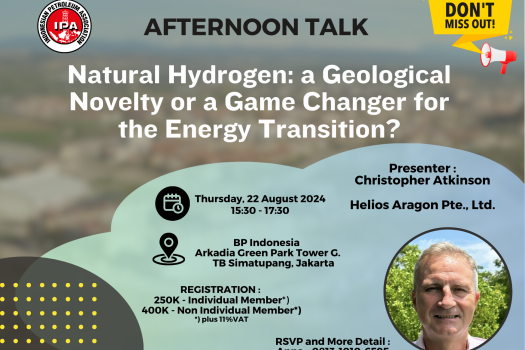AFTERNOON TALK : NATURAL HYDROGEN: A GEOLOGICAL NOVELTY OR A GAME CHANGER FOR THE ENERGY TRANSITION?
SUMMARY:
Hydrogen in its myriad of rainbow colours is currently a key component of the anticipated energy transition. Burning more cleanly than natural gas its main drawback has always been its expense to manufacture. Unfortunately, today’s methods for producing hydrogen either emit CO2 (steam reformation of methane) or require significant energy inputs (pyrolysis). Even the proposed panacea of green hydrogen using renewable wind/solar sources consumes more energy than it provides and is only viable with considerable government subsidies. In essence hydrogen today is an energy vector and not a source.
Finding a new way to produce hydrogen which does not require significant energy input nor emit CO2 yet is commercially viable is therefore extremely important for the World. Thankfully, there is another option which to date has garnered limited attention: natural hydrogen which is generated by geological processes. Given its potentially widespread existence and low cost of extraction it has been termed “white” or “gold” hydrogen.
In 2021 the world’s first international conference on natural hydrogen was held and the over the last two years the subject has been the focus of special interest meetings convened by the AAPG, SPE, GSL and SGF. Numerous commercial entities have been established to explore for natural hydrogen and resource assessments of natural hydrogen potential are underway by government-led bodies in the EU, USA and Australia.
One of the companies at the forefront in the search for natural hydrogen is Helios Aragón who plans to drill an appraisal well in 2024 on the natural hydrogen discovery made in 1963 at the Monzón-1 exploration well in northern Spain. The well intersected a significant gas column at a depth of around 3500 metres in the Triassic Bunter Sandstone. Despite strong shows of hydrogen gas (interestingly detected using a Prakla-Orsat mud gas show system and not a gas chromatograph) the well was not flow tested. The intriguing conclusion is that an accumulation of natural hydrogen awaits re-discovery and that this former “dry hole” in Spain could be a key component in the largest energy transition the world has ever seen.
ABOUT THE PRESENTER :
Chris has over 40 year’s experience in the energy/resource sector initially working for Shell and then Atlantic Richfield in their research divisions and ultimately as the Exploration Vice President of ARCO Europe/Eurasia.
Chris left “big oil” in 2000 and co-founded pda Limited which in 2004 became Serica Energy plc and which today is the 6th largest producer of oil and gas in the UK North Sea. From 2006-2016 he went on to build and finance numerous other successful E&P start-up companies all of which were either successfully IPO’d or trade sold to major international oil and gas companies. In 2018 Chris co-founded Helios Aragon which is exploring for natural or “gold” hydrogen/helium gas in Spain, Poland and other countries.
Chris currently acts as a non-executive director of Rex International Holdings in Singapore and as a board member for their subsidiary companies Lime Petroleum in Norway and Masirah Oil in Oman. In 2020 he was elected to the board of Far East Gold which is an eco-focused miner exploring for gold/copper in Indonesia.
Chris has a highly successful track record of building and financing start up energy and resource ventures with multi-fold returns to the shareholders. He is a past president and life member of SEAPEX and spent many years in the early 1990’s as an active council member of the Indonesian Petroleum Association.
Chris holds both a BSc and PhD in Geology from the University of Wales, UK.
registration link : https://forms.gle/w8UFHYaYHjhpQcBj6
RSVP : anna.sulistiyaningsih@ipa.or.id or WA +62-813-1010-6595


